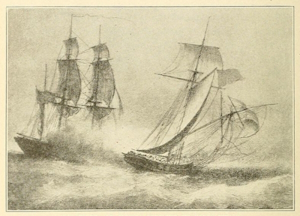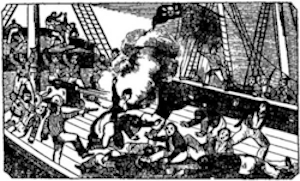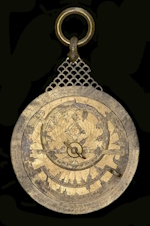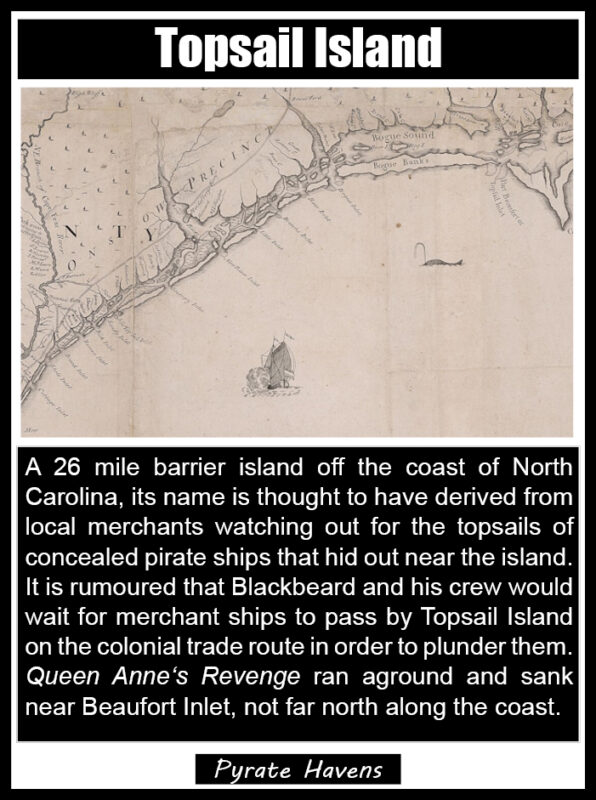 This act was passed during the reign of William III. The main purpose behind the statute was to make some corrections to the Offences at Sea Act 1536. These changes included allowing for acts of piracy to be “examined, inquired of, tried, heard and determined, and adjudged in any place at sea, or upon the land, in any of his Majesty’s islands, plantations, colonies, dominions, forts, or factories”. This enabled admirals to hold a court session to hear the trials of pirates in any place they deemed necessary, rather than requiring that the trial be held in England, thus avoiding the costly and time-consuming transport of captured pirates across the Atlantic. It also meant those accused of piracy didn’t necessarily have to be tried by a jury.
This act was passed during the reign of William III. The main purpose behind the statute was to make some corrections to the Offences at Sea Act 1536. These changes included allowing for acts of piracy to be “examined, inquired of, tried, heard and determined, and adjudged in any place at sea, or upon the land, in any of his Majesty’s islands, plantations, colonies, dominions, forts, or factories”. This enabled admirals to hold a court session to hear the trials of pirates in any place they deemed necessary, rather than requiring that the trial be held in England, thus avoiding the costly and time-consuming transport of captured pirates across the Atlantic. It also meant those accused of piracy didn’t necessarily have to be tried by a jury.
Category: Pirate way of life
The Piracy Act 1670
 This law was enacted during the reign of Charles II and its full name was An Act to prevent the delivery up of Merchants Shipps, and for the Increase of good and serviceable Shipping. It came into being because the captains and crews of merchant vessels commonly refused to fight when attacked by pirates. The act stipulated that ships of 200 tons or more possessing at least sixteen guns were required to fight, as long as the pirate vessel didn’t have twice as many guns. Failing to resist would result in the commander being excluded from any further commands of English ships and even imprisonment.
This law was enacted during the reign of Charles II and its full name was An Act to prevent the delivery up of Merchants Shipps, and for the Increase of good and serviceable Shipping. It came into being because the captains and crews of merchant vessels commonly refused to fight when attacked by pirates. The act stipulated that ships of 200 tons or more possessing at least sixteen guns were required to fight, as long as the pirate vessel didn’t have twice as many guns. Failing to resist would result in the commander being excluded from any further commands of English ships and even imprisonment.
Offences at Sea Act 1536
 In the 14th century Edward III (1327-1377) attempted to set up how admiralty courts should deal with piracy in A Remedy where a Merchant’s Good be robbed or perished on the Sea, but these were rather vague laws and there was often the problem of overlapping jurisdictions when dealing with such a crime. It was wasn’t until the reign of Henry VIII (1509–1547) that significant anti-piracy laws were enacted. Originally titled An Act for Pirates and Robbers on the Sea issued in 1535, it was renamed The Offences of Sea Act in 1536.
In the 14th century Edward III (1327-1377) attempted to set up how admiralty courts should deal with piracy in A Remedy where a Merchant’s Good be robbed or perished on the Sea, but these were rather vague laws and there was often the problem of overlapping jurisdictions when dealing with such a crime. It was wasn’t until the reign of Henry VIII (1509–1547) that significant anti-piracy laws were enacted. Originally titled An Act for Pirates and Robbers on the Sea issued in 1535, it was renamed The Offences of Sea Act in 1536.
This act allowed crimes such as robbery and murder to be tried as if they occurred on land. They could be tried in any county in England in any court commissioned by the king under related common law provisions for these offences. Those found guilty of piracy and treason at sea could not only be sentenced to death, but also have their lands and possessions seized.…
Navigational instruments
Astrolabe
 This device is thought to have been first developed by the ancient Greeks, the term astrolabe meaning ‘star taker.’ It is a primitive inclinometer that calculates the altitude of the sun and stars to determine latitude. An astrolabe can be used for both astronomy and navigation at sea. Elaborate astrolabes can have etchings of how the sky looks at any given time or season. Sailors used this device by lining it up with the sun or a specific star, such as the North Star, in relation to the horizon in order to measure latitude vertically. This helped sailors to determine their location while at sea. Astrolabes came in a variety of shapes, such as a sphere or as flat plates and disks, and were made of metal, usually brass or iron, the former ensuring longevity at sea. A disadvantage was that astrolabes were cumbersome and could be difficult to use on the rolling deck of a ship.…
This device is thought to have been first developed by the ancient Greeks, the term astrolabe meaning ‘star taker.’ It is a primitive inclinometer that calculates the altitude of the sun and stars to determine latitude. An astrolabe can be used for both astronomy and navigation at sea. Elaborate astrolabes can have etchings of how the sky looks at any given time or season. Sailors used this device by lining it up with the sun or a specific star, such as the North Star, in relation to the horizon in order to measure latitude vertically. This helped sailors to determine their location while at sea. Astrolabes came in a variety of shapes, such as a sphere or as flat plates and disks, and were made of metal, usually brass or iron, the former ensuring longevity at sea. A disadvantage was that astrolabes were cumbersome and could be difficult to use on the rolling deck of a ship.…

